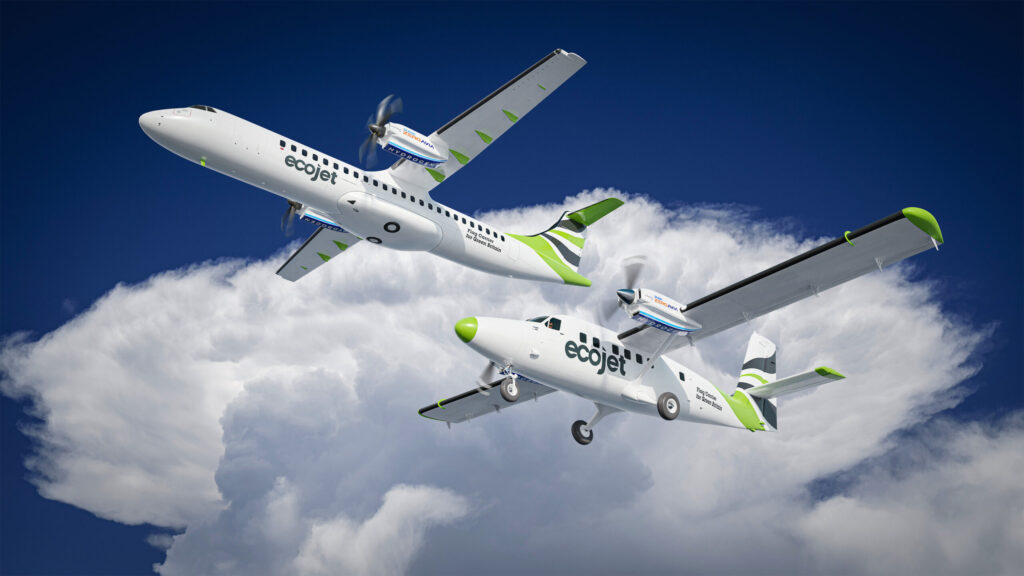Global Avionics Round-Up from Aircraft Value News (AVN)

Aircraft used by the Edinburgh-based Ecojet electric commercial airline. (Image: Ecojet)
One of the most ambitious projects in the new frontier of electric aviation is the Flying Fuel Cell concept, a hydrogen-electric hybrid system being actively pursued by several European aerospace firms and research institutions. This system doesn’t just swap out jet fuel for hydrogen; it redefines how propulsion works altogether.
In the Flying Fuel Cell model, hydrogen is stored in cryogenic tanks, delivered to fuel cells onboard the aircraft, and converted into electricity to power electric motors. This setup eliminates combustion, slashing emissions to zero and eliminating particulate output entirely. From an environmental standpoint, it’s a dream scenario. But from an avionics perspective, it’s a complex orchestration of critical systems.
Avionics manage the entire hydrogen-electric cycle: monitoring tank temperatures, managing the delicate balance of oxygen and hydrogen within the fuel cell, distributing electric power between motors and battery buffers, and responding in real time to changes in load, altitude, and thermal constraints. Failures in any of these systems could have cascading effects, making redundancy and software reliability paramount.
This means that future cockpits will need real-time displays and alerts for hydrogen levels, fuel cell output, and electrical system health, an entirely new language of flight management that pilots and technicians will have to learn. Fly-by-wire systems will need to communicate seamlessly with power-by-wire systems. It’s no exaggeration to say that avionics is the linchpin holding the Flying Fuel Cell vision together.
The New Avionics Paradigm
No longer just navigation, communication, and safety systems, avionics are becoming deeply entwined with propulsion, energy management, and environmental performance.
Avionics are now expected to:
- Manage power from multiple sources (batteries, fuel cells, SAF-burning engines);
- Balance thermal loads to prevent overheating;
- Interface with high-voltage electrical systems;
- Provide pilots with intuitive interfaces to control complex hybrid systems; and
- Incorporate AI-assisted decision-making for energy optimization.
In essence, green propulsion can’t exist without green avionics. These systems are setting the roadmap for next-gen eco-aircraft, where propulsion and avionics are no longer separate domains but parts of a unified, intelligent architecture.
A Divided Forecast: Is Electric the Next Disruption?
As with all major innovations, the aviation world is divided on the pace and scope of electric aircraft adoption. Some analysts argue that electrification is a genuine disruptor, poised to do to aviation what Tesla did to the auto industry. They cite prototype aircraft that are already flying, regulatory support, and a clear path to lower operating costs as reasons for their bullishness.
Others caution that electric aviation is still in its infancy. The energy density of current battery technology remains a significant barrier, making fully electric flight viable only for short routes and light payloads. They argue that hydrogen infrastructure is decades away from maturity, and that mainstream disruption is still at least 25 years off.
The reality lies somewhere in between. Widespread replacement of conventional jetliners is a long-term prospect. But the avionics industry isn’t waiting for that future; it’s already adapting. Whether or not electrification becomes dominant soon, it’s already redefining how avionics systems are built, integrated, and operated.
Indeed, manufacturers, maintenance providers, and FAA Part 147 schools already are laying the groundwork to support the next generation of electric aircraft, avionics, engines, and ground support equipment. As the aviation industry pivots toward sustainability, these stakeholders are racing to develop the infrastructure, training programs, and certification pathways needed to service electric propulsion systems and high-voltage components safely and efficiently.
This article originally appeared in our partner publication, Aircraft Value News.
John Persinos is the editor-in-chief of Aircraft Value News.